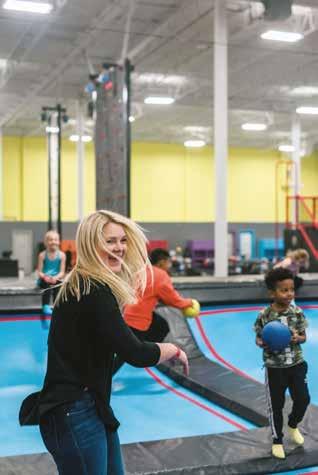
4 minute read
How mindfulness helps kids manage stress
By Christa Melnyk Hines
When kids are stressed, they ruminate about past problems and worry about future what-ifs.
Advertisement
Why are kids stressed?
Academic pressures, overstuffed schedules, unstable home life, economic hardship, social media, and peer pressure can all affect a student’s physical and mental health. According to the Center on the Developing Child at Harvard University, prolonged stress not only harms healthy development, it interferes with learning, behavior, and health throughout life.
What is mindfulness?
“Mindfulness is not a control mechanism or behavioral modification. It can be a calming technique, but not always. It’s more of helping a child become actively aware of how they are feeling and use some of their tools to manage those feelings,” says Lauren Wessinger, who facilitates the Mindful Project, an eight-week schoolbased program geared toward kindergarten to Grade 5 students. Mindfulness gives children - and adults - simple strategies to intentionally and without judgement notice what they’re feeling in the moment, observe their surroundings, and self-regulate their behavior.
Does it work?
To learn more about the effects of the practice on students, researchers at the University of California, Davis, partnered with Mindful Schools, a non-profit organization that teaches educators, parents, and mental health professionals how to integrate mindfulness into everyday learning at kindergarten to Grade 12 schools around the globe. Among students who participated in a mindfulness program, the researchers found significant improvement in paying attention and class participation.
Initial studies also suggest that mindfulness changes the brain’s architecture by helping kids become less reactive. They are better equipped to manage feelings like anger, sadness, fear, and worry.
“When they can’t control much outside of them, they can absolutely regulate what’s happening inside of them if they know how,” says Wessinger, who received her training through Mindful Schools.
Furthermore, the practice can enhance their compassion toward others and for themselves. “If kids can grow up knowing how to manage intense emotions and not let this intensity completely consume them, then maybe it will cause one child, who is then an adult, to make a different decision in the moment,” says Wessinger.
Begin with you
When you feel calm, your children will likely respond in kind. As part of her daily practice, Wessinger takes three deep breaths before she picks up her children, ages eight to 12, from school. “I’m more of a receptive, calm container. They don’t consciously know why, but their nervous system is like, ‘Okay, everything is cool. I’m safe right now.’ It’s like a nervous system to nervous system language,” she explains.
Start with just three to five minutes a day of quiet breathing and observing your emotions. Try challenging yourself by doing 10 days in a row for three minutes a day and add a minute as the practice becomes easier.
Teach your child deep breathing
Begin with a simple practice. For one to three minutes, have your child place their hand on their belly and feel the movement when they breathe. “The tension going down into that movement is about as present as you can get. Nothing’s really going on except belly moving, eyes closed, feeling the breath in the hand,” says Wessinger.
safe. clean. fun.
Mindful listening
Through intentional listening, kids learn to become more aware of their surroundings. Begin with three long and deep breaths. Suggest they close their eyes. Ring a bell or a chime and have them listen for the sound until they can no longer hear it. “When the noise goes away, they raise their right hand and then they take three deep breaths and then put their hand down,” suggests Wessinger.
Mindful seeing
In this exercise, kids stare at a point on the ground for about a minute. If they lose focus, encourage them to return back to the point on the ground. “I tell them you have super strong eye strength now. What is an animal that has great vision? They always say a bird,” says Wessinger.
She then has them use their eagle eyes to look around the room, noticing things they’ve never noticed before.
Practice heart awareness
In this visualization exercise, your child imagines reaching out to help a lonely friend. Ask them questions like, “How does that feel in your body when you are helping your friend?” Then, walk them through a visualization of them not helping their friend (but not doing anything cruel either). Perhaps instead of acknowledging their friend, they ignore them. Again, ask your child how that feels in their body and in their heart.
Walking mindfulness
Wessinger also takes her students on walking heartfelt meditations in which the kids walk silently around the school and send out kind thoughts toward anyone they see. “In our heads, we think, ‘May you be happy, may you be peaceful, may you be free,’” says Wessinger. “They love it. This is the piece that felt inspiring to me. It helps them understand, ‘When I do this action, I feel this way. Don’t I want to feel the good way as often as possible?’” she says.
Christa is a nationally-published freelance writer and mom of two teenage sons. CCM
Reduced capacity with the same family fun!

4 HOUR ADMISSION











